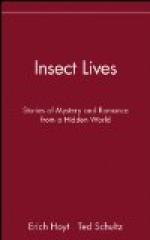The destruction of larval tissue and the development of replacing organs from special groups of cells, derived of course from the embryo, and carrying on the continuity of cell-lineage to the adult, are among the most remarkable facts connected with the life-story of insects. The process of tissue-destruction is known as ‘histolysis’; the rebuilding process is called ‘histogenesis.’ Considerable difference of opinion has existed as to factors causing histolysis, and for a summary of the conflicting or complementary theories, the reader is referred to the work of L.F. Henneguy (1904, pp. 677-684). In the histolysis of the two-winged flies, wandering amoeboid cells—like the white corpuscles or leucocytes of vertebrate blood—have been observed destroying the larval tissues that need to be broken down, as they destroy invading micro-organisms in the body. But students of the internal changes that accompany transformation in insects of other orders have often been unable to observe such devouring activity of these ‘phagocytes,’ and attribute the dissolution of the larval tissues to internal chemical changes. The fact that in all insect transformation a part, and in many a large part, of the larval organs pass over to the pupa and imago, suggests that only those structures whose work is done are broken down through the action of internally formed destructive substances, and one function of the phagocytes is to act as scavengers by devouring what has become effete and useless.
CHAPTER VI
LARVAE AND THEIR ADAPTATIONS
Among the insects that undergo a complete transformation, there is, as we have seen in the preceding chapter, an amount of inward change, of dissolution and rebuilding of tissues, that varies in its completeness in members of different orders. It is now advisable to consider the various outward forms assumed by the larvae of these insects, or rather by a few examples chosen from a vast array of well-nigh ’infinite variety.’
In comparing the transformations of endopterygote insects of different orders, it is worthy of notice that in some cases all the members of an order have larvae remarkably constant in their main structural features, while in others there is great variety of larval form within the order. For example, the caterpillars of all Lepidoptera are fundamentally much alike, while the grubs of beetles of different families diverge widely from one another. A review of a selected series of beetle-larvae will therefore serve well to introduce this branch of the subject.
[Illustration: Fig. 12. a, Carrion-beetle (Silpha) with its larva, b. Magnified, a 3 times, and b 4 times.]
[Illustration: Fig. 13. Larva of a Ground-beetle (Aepus). Magnified 6 times. After Westwood, Modern Classification of Insects.]




